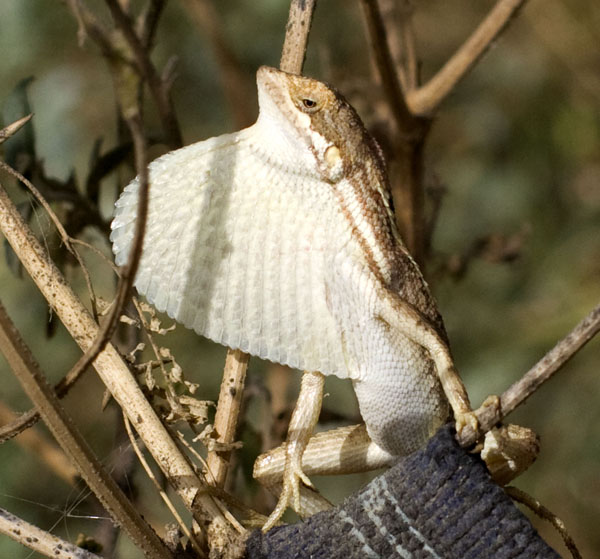Even though anoles aren’t the only lizards to have evolved dewlaps, their spectacular diversity of dewlap shapes and sizes certainly makes them leaders in the global arms race for dewlap dominance. Nevertheless, I recently came across some photos of the spectacularly dewlapped-agamid Sitana ponticeriana doing something I don’t think anoles are capable of – displaying while standing on two hind limbs. I’ve seen Australian agamids stand up for extended periods of time to display, dissipate heat, or scan the horizon, but I’ve never seen an anole do this for more than a few seconds while reaching for a new perch. Sure, anoles can do lots of other stuff to get the message across – push-ups, full-ups, elaborate tail-wags, tongue protrusions, nuchal crest extensions, gapping, etc. – but I’m just not sure they’re built to stand. My question to all the anoles lovers out there: has anybody ever seen one of our beloved creatures displaying while standing on its hind-limbs?
PS – Lots of other amazing photos of the dewlapped agamids are on Flickr
- JMIH 2014: Early Records of Fossil Anolis from the Oligocene and Miocene of Florida, USA - August 13, 2014
- JMIH 2014: Relative Contribution of Genetic and Ecological Factors to Morphological Differentiation in Island Populations of Anolis sagrei - August 7, 2014
- JMIH 2014: The Ultrastructure of Spermatid Development within the Anole, Anolis sagrei - August 5, 2014



Jonathan Losos
The agamid photos in the link in your p.s. are amazing, but I’m confused about Sitana ponticeriana, which appears to exhibit a wide range of dewlap colors. Is it really a single species?
Ambika Kamath
My Indian reptile guide says that males acquire the bright colouration on their dewlaps only in the breeding season, so part of the variation might be seasonal
Jonathan Losos
Wow. That’s pretty amazing. Could individuals change from looking like the picture above to this from one season to the next?

Mary Jane West-Eberhard
According to Pal et al [2011, Tapbrobonica 3(3):31-37], an Indonesian journal,
“immature adult males” have white dewlaps and then later (in the breeding season) acquire the bright dewlap coloration. As in many Anolis, the bright dewlaps are displayed during territorial defense against other males, and in courtship (G. Dhane, 2007, Hornbill July-Sept 2007, pp.36-37). While some would argue that the courtship display is species recognition, the use of the dewlap as part of male-male competition for mates fits Darwin’s theory of sexual selection, as does the use during courtship (obviously, elements of the same display could function both in species recognition and in mates).
Ambika Kamath
Another factor in favour of the use of the fan in sexual selection and not species recognition is that, unlike anoles, Sitana only rarely co-occur with any other lizards that look remotely similar. In two months of field work, the only other agamid I’ve seen at sites with Sitana is Calotes versicolor…
Rich Glor
Thanks for these additional insights. I just got a book from 2009 by Somaweera and Somaweera on the lizards of Sri Lanka that includes a few more photos of Sitana and mentions the seasonally changes. It doesn’t however, give details on what these changes involve or provide any new photos with the dewlap fully extended.
Ambika Kamath
I’ve been photographing a lot of male dewlaps in the breeding season, and in a few months we should also have photos of male Sitana dewlaps in the nonbreeding season from two of my sites, which should give us a good idea of the changes…I’ll post those pictures when I get them!
Donald Miles
Perhaps there are male morphs.
Joe Macedonia
The coloration of the orange, black, and blue dewlap of Sitana ponticeriana in the photos is indeed incredible. The structurally colored blue scales appear to be highly iridescent, and it wouldn’t be surprising to find that they reflect UV wavelengths as well. As for the uniqueness of the stance, anoles are not to be outdone by this admittedly impressive agamid. Tom Jenssen illustrated a point-for-point identical display posture in Anolis nebulosus in a 1970 paper entitled “The ethoecology of Anolis nebulosus (Sauria, Iguanidae)” (J. Herp. 4:1-38, Fig. 11b on page 24). Have a look!